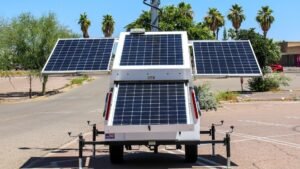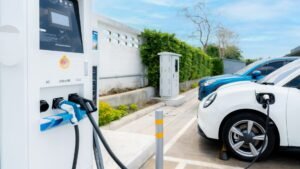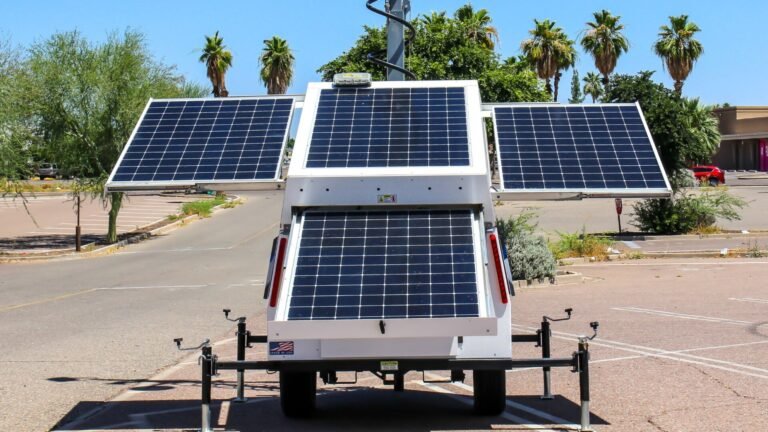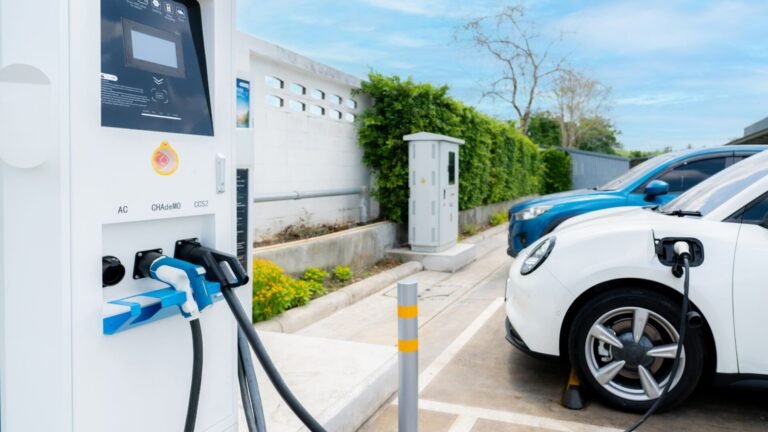As the world increasingly embraces renewable energy, solar power stands out as a leading source of clean, sustainable energy.
With the growing awareness of environmental issues and the need to reduce carbon footprints, more individuals and businesses are turning to solar energy as a viable alternative to traditional power sources.
However, one of the most common questions potential solar adopters have is: “How much power do solar panels produce?” Understanding this is crucial for making informed decisions about solar investments.
This blog delves into the factors affecting solar panel efficiency and power output, offering a comprehensive guide to understanding solar panel power and helping you make the most of your solar energy system.
Whether you’re a homeowner looking to reduce electricity bills or a business aiming to enhance sustainability, knowing how solar panels work and their power potential is essential.
Understanding Solar Panel Efficiency
Solar panel efficiency refers to the portion of sunlight that a solar panel can convert into usable electricity. This efficiency is a critical factor in determining the overall performance and output of a solar power system.
The efficiency of solar panels has improved significantly over the years, thanks to advancements in technology and manufacturing processes.
These improvements have made solar energy more accessible and cost-effective for both residential and commercial applications.
Modern solar panels typically have an efficiency rate ranging from 15% to 22%. This means that out of all the sunlight hitting the panel, 15% to 22% is converted into electrical energy, with the rest being lost as heat or reflected away.
Enhanced efficiency not only increases the power output but also reduces the number of panels needed to meet energy demands, making solar installations more space-efficient and aesthetically pleasing.
Factors Influencing Solar Panel Efficiency
Type of Solar Cells: The type of photovoltaic (PV) cells used in a solar panel significantly impacts its efficiency. Monocrystalline solar cells are known for their high efficiency and longevity.
They are made from a single continuous crystal structure, which allows for more unobstructed movement of electrons, thus enhancing their efficiency.
On the other hand, polycrystalline cells, made from silicon crystals melted together, are slightly less efficient but more cost-effective.
Polycrystalline panels are easier and cheaper to manufacture, making them a popular choice for those balancing cost and performance.
Additionally, thin-film solar cells, although less efficient, offer flexibility and lighter weight, making them suitable for certain applications.
Quality of Materials: The quality of the materials used in the construction of solar panels directly affects their efficiency.
Higher-quality materials can better withstand environmental factors like extreme weather conditions, UV radiation, and physical wear and tear, resulting in less degradation over time.
For instance, high-grade silicon used in monocrystalline panels can maintain high efficiency levels for decades.
Additionally, superior anti-reflective coatings can increase light absorption, and robust framing materials like anodized aluminum can provide better structural integrity and longevity.
Investing in high-quality materials may result in higher upfront costs but ensures more efficient and durable solar panels in the long run.
Panel Orientation and Angle: The angle and orientation of solar panels play a crucial role in their efficiency. Panels should be installed to maximize exposure to sunlight throughout the day.
Typically, this means facing south in the northern hemisphere and north in the southern hemisphere. However, the optimal angle also depends on the latitude of the installation site.
Adjusting the tilt angle of the panels seasonally can further enhance their performance by aligning them more directly with the sun’s path.
For instance, a steeper angle might be beneficial in winter months to capture lower sun angles, while a flatter angle could be advantageous in summer.
Temperature: Surprisingly, solar panels are more efficient in cooler temperatures. High temperatures can reduce the efficiency of solar panels by causing the electrical circuits to overheat.
This phenomenon, known as the temperature coefficient, means that for every degree Celsius increase in temperature, the efficiency of a typical silicon-based solar panel can drop by approximately 0.5%.
Therefore, installations in hot climates may experience lower efficiency compared to those in cooler areas. Proper ventilation and airflow around the panels can help mitigate overheating.
Moreover, advancements in solar technology are continually improving the temperature resilience of solar panels, making them more suitable for a wider range of climates.
Shade and Obstructions: Any shade or obstructions, such as trees, buildings, or even dirt and debris, can significantly reduce the amount of sunlight hitting the solar panels, thus lowering their power output.
Even partial shading of a single panel can impact the performance of the entire solar array due to the way panels are interconnected.
Modern panels often include bypass diodes to mitigate the effects of shading by allowing current to bypass shaded cells.
Regular maintenance, such as cleaning the panels and trimming nearby foliage, is essential to ensure maximum exposure to sunlight.
Strategic placement and the use of solar design software can also help in planning installations to minimize shading impacts.
How Much Power Do Solar Panels Produce?
The power output of solar panels, often referred to as solar panel power, depends on several factors, including the size of the panel, the efficiency of the solar cells, and the amount of sunlight received. Here’s a closer look at these factors:
Panel Size: The size of a solar panel is directly proportional to its power output. Larger panels can accommodate more solar cells, leading to higher power production.
For instance, a standard residential solar panel typically measures around 65 inches by 39 inches and produces about 300 watts of power.
Commercial panels can be even larger, producing upwards of 400 watts per panel. The total power output of a solar array is the sum of the output of each individual panel, making the physical size and number of panels crucial factors in determining overall power generation.
Sunlight Exposure: The amount of sunlight a solar panel receives is critical in determining its power output. Areas with longer daylight hours and fewer cloudy days will produce more power.
Solar panels in sunny climates like those found in the southwestern United States, Australia, or the Mediterranean can generate significantly more electricity than panels located in regions with frequent cloud cover or shorter daylight hours.
Additionally, the angle and direction of the panels play a role in maximizing sunlight exposure. Panels should be installed facing true south (in the northern hemisphere) or true north (in the southern hemisphere) at an angle equal to the latitude of the location for optimal performance.
System Size: The overall size of the solar power system, typically measured in kilowatts (kW), will determine the total power production.
A 5 kW solar system, for example, consists of several panels that together produce 5 kilowatts of power. This is roughly enough to power a medium-sized home, depending on energy consumption patterns.
Larger systems, such as those used in commercial or industrial settings, can range from 10 kW to several megawatts (MW).
The capacity of the system should be matched to the energy needs of the building or facility, taking into account peak usage times and seasonal variations in sunlight.
System size is also influenced by the available roof space or land area for installation.
Maximizing Solar Panel Power
To get the most out of your solar panels, consider the following tips:
Optimal Placement: Ensure your solar panels are installed in a location that receives maximum sunlight exposure, with minimal shading throughout the day.
Proper placement involves conducting a thorough site assessment to determine the best angle and orientation for the panels.
In addition, it’s crucial to consider potential future obstructions, such as growing trees or new buildings, that could cast shadows on the panels.
By positioning the panels optimally, you can significantly enhance their power output and overall efficiency, ensuring they capture the maximum amount of sunlight available.
Regular Maintenance: Keep your panels clean and free from debris. Regular maintenance ensures that your panels operate at peak efficiency.
Dust, leaves, bird droppings, and other debris can accumulate on the surface of solar panels, blocking sunlight and reducing their effectiveness.
Scheduled cleaning, especially in areas with high pollution or frequent dust storms, can prevent this buildup.
Additionally, regular inspections for damage or wear can identify issues early, allowing for timely repairs. Proper maintenance not only maximizes power production but also extends the lifespan of your solar panel system, providing better returns on your investment.
Quality Equipment: Invest in high-quality solar panels and components. While the initial cost may be higher, the long-term benefits of increased efficiency and durability outweigh the costs.
High-quality panels typically offer better performance, especially in low-light conditions, and are less prone to degradation over time.
Moreover, superior inverters and mounting systems contribute to the overall efficiency and reliability of your solar setup.
Investing in reputable brands with strong warranties ensures that your system will deliver consistent power output for many years, ultimately saving money on energy bills and maintenance costs.
Professional Installation: Have your solar panels installed by certified professionals to ensure they are set up correctly and safely.
Professional installers have the expertise to handle complex electrical connections and ensure that the panels are securely mounted to withstand harsh weather conditions.
They can also optimize the layout of the panels to maximize sun exposure and minimize energy losses. Furthermore, certified installers are familiar with local building codes and regulations, ensuring that your installation complies with all legal requirements.
By choosing professional installation, you enhance the efficiency, safety, and longevity of your solar power system.
Solar Panel Power in Different Conditions
The efficiency and power output of solar panels can vary based on geographical location and weather conditions. For instance, solar panels in sunny climates like southern Spain or Italy will produce more power than those in cloudier regions such as the United Kingdom or northern Germany.
In sunnier locations like Andalusia in Spain, the increased amount of direct sunlight can significantly boost the energy production of your solar panels.
Conversely, in areas with frequent overcast weather or heavy rainfall, such as Manchester in the UK or Hamburg in Germany, solar panels will experience reduced sunlight exposure, resulting in lower power output.
However, modern solar technology has improved to such an extent that even in less sunny regions, solar panels can still provide a substantial amount of power.
Additionally, the use of solar tracking systems, which adjust the angle of the panels to follow the sun throughout the day, can further optimize power production in varying conditions.
Proper installation and strategic placement are key to maximizing solar panel power in any environment, ensuring you get the most out of your investment regardless of location.
Conclusion
Understanding solar panel power and efficiency is crucial for anyone considering switching to solar energy.
By considering factors such as panel type, quality, orientation, and local climate, you can maximize the power output of your solar panels.
Investing in solar energy not only helps reduce your carbon footprint but also significantly lowers your energy bills over time. With the right setup and maintenance, solar panels can provide a reliable source of clean energy for decades.
At Tamesol, we specialize in providing high-efficiency solar panels that deliver optimal performance, regardless of the conditions.
Our panels are designed to maximize power output and provide sustainable energy solutions for all your needs.
Whether you’re looking to power a residential property or a large commercial installation, Tamesol offers customized solar solutions tailored to your specific requirements.
Contact Tamesol today to learn how our solar panels can help you harness the power of the sun effectively and efficiently.
Our team of experts is ready to guide you through the entire process, from selection and installation to maintenance and support, ensuring you achieve the best possible results with your solar energy system.





